Early intensive behavioral intervention has been clearly demonstrated to improve learning, communication and social skills in young children with autism. The primary goal of treatment is to improve the overall ability of the child to function effectively in the world. The exact form of treatment depends on the child’s individual needs, and includes understanding the child’s strengths and deficits, what motivates the child, and the child’s best learning modality. In most cases, a combination of treatment methods is more effective. In some cases, some form of treatment may be necessary throughout the affected person’s life, although exactly what form that treatment takes will depend on the developmental level and specific needs of the person at each life stage.
 There are many different types of treatments available. These strategies can be broken down into the following categories:
There are many different types of treatments available. These strategies can be broken down into the following categories:
-
- Behavior and communication approaches
- Medication
- Complementary and alternative medicine
Behavior and communication approaches
According to reports by the American Academy of Pediatrics and the National Research Council, behavior and communication approaches that help children with ASDs are those that provide structure, direction and organization for the child in additional to family participation.
Applied Behavior Analysis (ABA)
Among the many methods available for the treatment and education of people with autism, applied behavior analysis (ABA) has become widely accepted as an effective treatment. ABA, discussed in more detail in other places on this website, seeks to maximize the child’s ability to interact successfully with the world. The child’s progress toward very specific goals is tracked and measured. Today, ABA is widely recognized as a safe and effective treatment for autism.
A successful program will build on the child’s interests, offer a predictable schedule, teach tasks as a series of simple steps, actively engage the child’s attention in highly structured activities, and provide regular reinforcement of behavior. Parental involvement has emerged as a major factor in treatment success. Parents work with teachers and therapists to identify the behaviors to be changed and the skills to be taught. Recognizing that parents are the child’s earliest teachers, more programs are beginning to train parents to continue the therapy at home.
ABA consists of a large gamut of interventions all sharing common underlying principles. Some of these interventions are listed below, although this represents a small sample of techniques:
Discrete Trial Training (DTT) – DTT is a style of teaching that uses a series of trials to teach each step of a desired behavior or response. Lessons are broken down into their simplest parts and positive reinforcement is used to reward correct answers and behaviors. Incorrect answers are ignored.
Early Intensive Behavioral Intervention (EIBI) – This is a type of ABA for very young children with ASD, usually younger than five, and often younger than three.
Pivotal Response Training (PRT) – PRT aims to increase a child’s motivation to learn, monitor his own behavior and initiate communication with others. Positive changes in these behaviors should have widespread effects on other behaviors.
Verbal Behavior Intervention (VBI) – VBI is a type of ABA that focuses on teaching verbal skills.
Non-contingent Reinforcement (NCR) – Creates a positive learning environment and increases the likelihood of learning new skills.
Incidental Teaching – Sometimes grouped with PRT, incidental teaching capitalizes on “natural” environmental influences to teach certain skills.
There are literally hundreds if not thousands of techniques in the repertoire of skilled behavior analysts. Those mentioned above are but a small sample.
Other therapies that can be part of a complete treatment program for a child with ASD include:
Developmental Individual Differences Relationship-Based Approach (DIR, also called “Floortime”) – Floor time focuses on emotional and relational development (feelings, relationships with caregivers). It also focuses on how a child deals with sights, sounds and smells. This is a form of play therapy that has not had nearly the research evidence support of ABA. Typically, some aspect of play therapy (DIR, Floortime, etc.) is incorporated into a quality ABA program, but is not central to it.
Treatment and Education of Autistic and related Communication-handicapped Children (TEACCH) – TEACCH uses visual cues to teach skills. For example, picture cards can help teach a child how to get dressed by breaking information down into small steps.
Occupational Therapy
Sensory Integration Therapy
Speech Therapy
Picture Exchange Communication System (PECS)
Medication
To learn more about medications and ASDs, go to the National Institute of Mental Health Autism website.
Complementary and alternative medicine
To learn more about CAM therapies, go to the National Center for Complementary and Alternative Medicine “Get the Facts” webpage.
 INTERNATIONAL CHILD DEVELOPMENT CENTER “They may forget what you said but they will never forget how you made them feel” Carol Buchner
INTERNATIONAL CHILD DEVELOPMENT CENTER “They may forget what you said but they will never forget how you made them feel” Carol Buchner